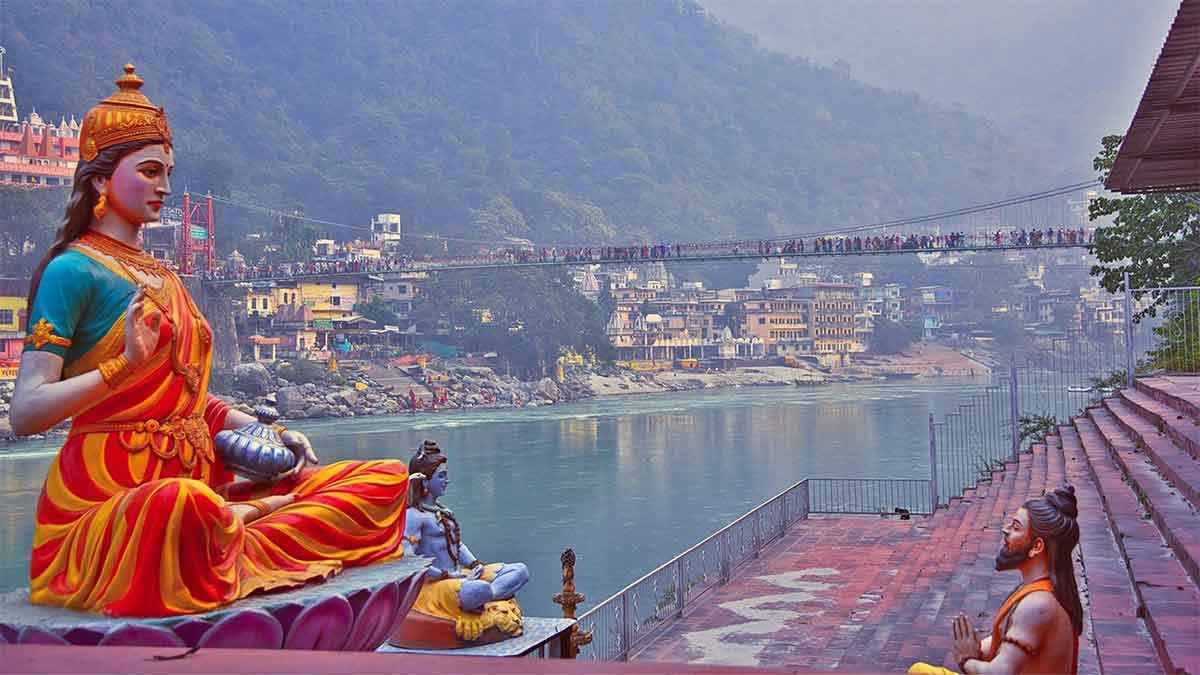The holy town of Rishikesh is immersed in the history of mythical stories and numerous legends. This ‘Abode of the Gods’ is India’s oldest and most important pilgrimage site. As per the ancient ‘Skanda Purana’, Rishikesh was previously called ‘Kubark’ as it was at this place that Lord Vishnu had appeared in front of Rabhya Rishi who was meditating under a mango tree. Hence, as the legend goes, the entire area began to be called ‘Kedarkhand’ which is now present-day Garhwal. Also, the sacred river Ganga flows through Rishikesh and the place is surrounded by the Shivalik mountain range. The entire landscape of the place gives Rishikesh a surreal and mystical aura which is hard to miss.
This article will delve into the various legends surrounding the name Rishikesh and how Rishikesh became an important pilgrimage center for devotees and saints alike.
From Hrishikesh to Rishikesh: How this place began to be called Rishikesh?
According to mythical legend, the city got its present-day name from Hrishikesh or ‘Lord of the senses’, another name of Lord Vishnu. As the legend goes, the great Hindu saint Rabhya rishi maintained prolonged abstinence and austerity at this place on the banks of the river Ganga. Lord Vishnu in the Satya Yuga (foremost of the four yugas), Lord Vishnu took the form of Hayagriva and killed Madhu and Kaitabha, both demons in a battle that lasted 5000 years. After the battle, Lord Vishnu went into the forest as repentance and saw Rabhya rishi meditating under a mango tree. As per the Skanda Purana, Lord Vishnu was impressed by the Saint’s spiritual practice and he appeared before him in the incarnation of Lord Hrishikesh and blessed the saint through a divine message. The place was then rechristened by Lord Vishnu as Hrishikesh as a reward for the saint’s prolonged austerity. The word Hrishikesh denotes Lord of the senses or in other words Lord Vishnu himself.
As per another legend, due to a fierce fire in Hrishikesh, Lord Shiva got angry with the Agni deity and cursed him. Lord Agni then fervently prayed at this place for repentance and hence the place began to be called ‘Agni Tirth’ aka the holy place of repentance of the Fire god or Agni devta.
As the folklore goes, the city gets its name from the words ‘Rishi’ which means sages, hermits and prophets. Also, the word ‘Kesh’ denotes dreadlocks. Many hermits even today walk through this holy city towards Char Dham. They have long hair which they usually wash in the sacred waters of the river Ganga. Hence, the place began to be known as Rishikesh.
Other Interesting Legends Associated With Rishikesh
It is impossible not to mention the legend of Ram Jhula and Lakshman Jhula while talking about the history of the origins of Rishikesh. According to a legend, Lord Rama bathed in the holy waters of Ganga at this place after killing Ravana, the demon king of Lanka. Meanwhile, Lakshman, the younger sibling of Lord Rama crossed the Ganga by building a bridge with jute ropes. So, the bridge was called ‘Lakshman Jhula’ in honor of Lakshman. This jute rope bridge was replaced by an iron suspension bridge in 1889 which was washed away in the floods of 1924. The bridge was however reconstructed and opened for public use by 1939. A similar bridge by the name ‘Ram Jhula’ was constructed in 1986 in the vicinity of Sivananda Nagar.
The famed Neelkanth temple in Rishikesh is situated exactly at the place where Lord Shiva and Neelkanth drank the poison that was released into the Samudra Manthan by the gods and demons in order to gain the elixir or ‘Amrit’ as mentioned by some mythical legends. In the aftermath, Lord Shiva’s throat turned blue due to poison consumption and hence the temple was called Neelkath temple.
Evolution of Rishikesh into a Pilgrimage Site
Since, the ancient period, Rishikesh was considered a sacred place for Hindu devotees and saints. However, the place’s religious significance grew in the early medieval period when in the 8th century, Adi Shankaracharya, one of the most revered Indian sages built many ashrams and temples in the region. However, most of these revered places could not withstand the ravages of time and are now in ruins due to earthquakes and floods. But, temples like Lakshman Mandir and Shatrugna Mandir still reminisce the erstwhile era of rich cultural heritage.
As per a legend, Lord Rama’s brother Bharat performed penance in Rishikesh. In the same place stands the ‘Bharat temple’ which was built by Adi Shankaracharya in the 6th century. Besides these ancient temples, now there are many other ashrams and temples which have sprung up in the vicinity of Rishikesh and on the banks of the Holy Ganges that attract devotees from all over the world.
Rishikesh’s Transformation Into The ‘Yoga Capital Of The World’
Rishikesh, besides being known as a pilgrimage center also attracts yogis from around the world. Today, many yoga shalas and yoga studios now dot the city’s landscape. This proliferation of yoga schools in Rishikesh can be traced back to 1924 when Swami Sivananda came to Rishikesh and found his mentor at this holy site. Over the next years, Swami Sivananda opened many hospitals, pharmacies, temples, ashrams and related organizations. His teachings drew masses of people and his philanthropic service gained many followers over a period of time. Eventually, Swami Sivananda retired to Mahasamadhi in 1963. However, he left behind a considerable number of disciples who took his teachings far and wide through the realms of yoga.
Although known as a religious place in India, the one event that put Rishikesh on the world map was in 1968, the year when the Beatles, the famed English rock band visited Rishikesh. They stayed at the ‘Maharishi Mahesh Yogi Ashram’ and studied transcendental meditation. Also, it was in Rishikesh that the band wrote most of the songs of their famous ‘The White Album’. The band was followed right till Rishikesh by their ardent fans, some with strumming guitars while others with yoga mats perched on their backs. Whatever may be the reason, the Beatles firmly established Rishikesh’s legacy as the ‘yoga capital of the world’.
Closing Thoughts
Rishikesh today as we know it is not only an important pilgrimage center but has also evolved into a land for yoga and spirituality. Moreover, its natural beauty notwithstanding, many tourists also flock to Rishikesh for some adrenaline-pumping outdoorsy activities. But, the erstwhile Hrishikesh has a rich history immersed in legendary mythical stories and folklore. Its rich past beautifully complements its present-day glory to make Rishikesh the most sought-after destination across the world.





